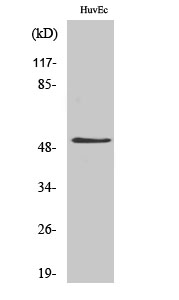Phospho DAPK3 (T265) Cell-Based Colorimetric ELISA Kit
- Catalog No.:KA1448C
- Applications:ELISA
- Reactivity:Human;Mouse;Rat
- Gene Name:
- DAPK3
- Human Gene Id:
- 1613
- Human Swiss Prot No:
- O43293
- Mouse Swiss Prot No:
- O54784
- Rat Swiss Prot No:
- O88764
- Storage Stability:
- 2-8°C/6 months
- Other Name:
- Death-associated protein kinase 3 (DAP kinase 3) (EC 2.7.11.1) (DAP-like kinase) (Dlk) (MYPT1 kinase) (Zipper-interacting protein kinase) (ZIP-kinase)
- Detection Method:
- Colorimetric
- Background:
- catalytic activity:ATP + a protein = ADP + a phosphoprotein.,cofactor:Magnesium.,function:Serine/threonine kinase which acts as a positive regulator of apoptosis. Phosphorylates histone H3 on 'Thr-11' at centromeres during mitosis.,similarity:Belongs to the protein kinase superfamily. CAMK Ser/Thr protein kinase family. DAP kinase subfamily.,similarity:Contains 1 protein kinase domain.,subcellular location:Relocates to the cytoplasm on binding PAWR where the complex appears to interact with actin filaments (By similarity). Associates to centromeres from prophase to anaphase.,subunit:Homodimer or forms heterodimers with ATF4. Both interactions require an intact leucine zipper domain and oligomerization is required for full enzymatic activity. Also binds to DAXX and PAWR, possibly in a ternary complex which plays a role in caspase activation. Interacts with AATF and CDC5L.,
- Function:
- chromatin organization, protein amino acid phosphorylation, phosphorus metabolic process, phosphate metabolic process, apoptosis, induction of apoptosis, intracellular signaling cascade, protein kinase cascade, cell death,regulation of cell death, positive regulation of cell death, programmed cell death, induction of programmed cell death,death, phosphorylation, chromatin modification, neuron differentiation, regulation of apoptosis, positive regulation of apoptosis, regulation of programmed cell death, positive regulation of programmed cell death, chromosome organization,
- Subcellular Location:
- Nucleus . Cytoplasm . Predominantly localizes to the cytoplasm but can shuttle between the nucleus and cytoplasm; cytoplasmic localization is promoted by phosphorylation at Thr-299 and involves Rho/Rock signaling. .; [Isoform 1]: Nucleus . Cytoplasm .; [Isoform 2]: Nucleus . Cytoplasm .
- Expression:
- Widely expressed. Isoform 1 and isoform 2 are expressed in the bladder smooth muscle.
- June 19-2018
- WESTERN IMMUNOBLOTTING PROTOCOL
- June 19-2018
- IMMUNOHISTOCHEMISTRY-PARAFFIN PROTOCOL
- June 19-2018
- IMMUNOFLUORESCENCE PROTOCOL
- September 08-2020
- FLOW-CYTOMEYRT-PROTOCOL
- May 20-2022
- Cell-Based ELISA│解您多样本WB检测之困扰
- July 13-2018
- CELL-BASED-ELISA-PROTOCOL-FOR-ACETYL-PROTEIN
- July 13-2018
- CELL-BASED-ELISA-PROTOCOL-FOR-PHOSPHO-PROTEIN
- July 13-2018
- Antibody-FAQs


